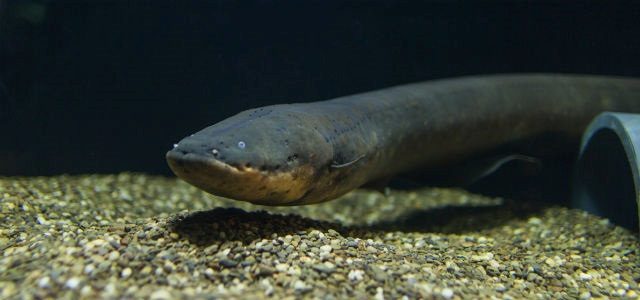
A newly discovered species of electric eel produces the highest voltage discharge of any known animal.
The creature, which delivers an electric shock of up to 860 volts – more than 200 volts higher than ever previously recorded, is one of two new species of electric eel.
But they are unlikely to kill a human, according to experts.
It had been previously thought that there was just one species of electric eel.
But a new study has revealed that there are at least three species of electric eels.
Scientists say the eels use their electric shock for both defence and hunting.
Electric eels are naked-back knifefishes (Gymnotidae) and are more closely related to catfish and carp than to other eel families.
The new study, published in the journal Nature Communications, not only provides new knowledge about the animal more than 250 years after it was first described but also opens up new avenues of research into the origin and production of strong electric discharges in other fish species.
Gymnotiformes, the knifefish family to which Gymnotidae belong, are native to Mexico and South America, are found almost exclusively in freshwater habitats, and are mostly nocturnal.
There are currently around 250 valid gymnotiform species among 34 genera and five families.
All are capable of producing a weak electric field for communication and navigation. Most have very small eyes.
Study first author Doctor Carlos David de Santana, an associate researcher at the US National Museum of Natural History (NMNH), said: “The electric eel, which can reach 2.5 metres in length, is the only fish that produces such a strong discharge; it uses three electric organs.
“The shock is used for defence and predation.”
By correlating DNA, morphology and environmental data, and measuring the discharged voltage, the researchers concluded that the animals in question should be reclassified into three species.
The only species of electric eel previously known to science was Electrophorus electricus, which Swedish naturalist Carl Linnaeus described in 1766.
In addition to E. electricus, now defined as the species that lives in the northernmost part of the Amazon region, the researchers found sufficient differences to add two new species to the genus: E. varii and E. voltai.
Study principal investigator Professor Naércio Menezes, of the University of Sao Paulo’s Zoology Museum in Brazil, said: “We used voltage as the key differentiation criterion.
“This has never been done before to identify a new species.”
During field measurements using a voltmeter, he said the research team recorded a discharge of 860 volts, the highest found in any animal, for a specimen of E. voltai.
The strongest shock previously recorded was 650 volts.
The name of the species pays homage to Italian physicist Alessandro Volta, who invented the electric battery in 1799, basing its design on the electric eel.
E. varii is named after zoologist Richard P. Vari, an American researcher who died in 2016.
Dr Santana added: “He was the foreign researcher who most influenced and helped Brazilian students and researchers with the study of fish in South America.”
Dr Santana, who has entered many rivers to collect electric eels for research purposes and been shocked more than once, said the discharge is high voltage but low amperage – around one amp, so it is not necessarily dangerous to humans.
As a comparison, a shock from a power outlet can be 10 or 20 amps. If you are unfortunate enough to receive one, you may be unable to pull your finger out, in which case it can be lethal.
But Dr Santana explained that the electric eel emits not a direct current but an alternating current – in pulses, and its charge is depleted after a strong shock.
Its electric organ takes some time to recharge.
But, even so, Dr Santana said an encounter with a bed of electric eels in the water can be quite perilous.
He said the shock will not kill a healthy person, but it can be hazardous if you have a weak heart. It can also contribute to a fall or drowning.
Dr Santana said: “The shock stuns the victim.
“It’s sufficiently strong to help the fish capture prey or scare off a predator.”
The research conducted by the group has shown that electric eels communicate to convene groups that can electrocute a potential threat.
Contrary to what had been previously claimed in scientific literature, the eels are not solitary and frequently associate in groups of up to 10 during adulthood.
The new classification was based on an analysis of 107 specimens collected in different parts of the Amazon in Brazil, Surinam, French Guiana and Guyana.
Dr Santana said: “Their body shape is highly conserved.
“It has not changed much during 10 million years of evolution.
“Only a few details of their external morphology distinguish them, and only an integrated analysis of morphology, genetics and ecology was able to make robust distinctions between the species.”
He added: “The discovery of new electric eel species in Amazonia, one of the planet’s biodiversity hotspots, is suggestive of the vast amount of species that remain to be discovered in nature.
“Furthermore, the region is of great interest to other scientific fields, such as medicine and biotechnology, reinforcing the need to protect and conserve it, and is important for studies involving partnerships among Brazilian researchers, and between us and groups in other countries, to explore the region’s biodiversity.”